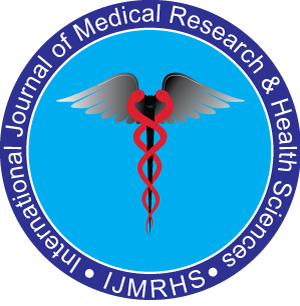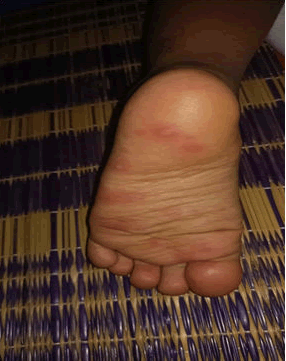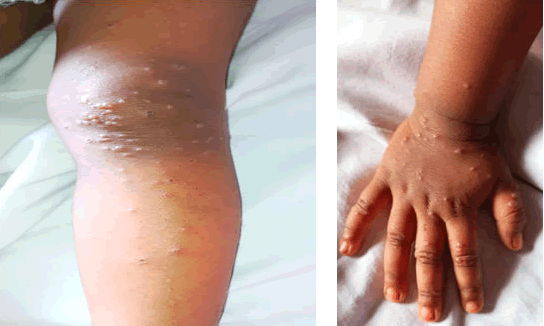Case Presentation - International Journal of Medical Research & Health Sciences ( 2025) Volume 14, Issue 2
Hand Foot and Mouth DiseaseâA Case Study and Patient CounsellingHand Foot and Mouth Disease-A Case Study and Patient Counselling
H Hema Nandhini*, R Rajamurugan, R Jasmiya Claives and P SasikumarH Hema Nandhini, Department of Pharmacy Practice, SSM College of Pharmacy, Jambai, Erode-638312, India, Email: hemaharichandar03@gmail.com
Received: 24-Aug-2023, Manuscript No. IJMRHS-23-111164; Editor assigned: 28-Aug-2023, Pre QC No. IJMRHS-23-111164 (PQ); Reviewed: 12-Sep-2023, QC No. IJMRHS-23-111164; Revised: 01-Apr-2025, Manuscript No. IJMRHS-23-111164 (R); Published: 08-Apr-2025
Abstract
A 2-year-old female young child was admitted to the hospital with complaints of fever, lack of appetite, reddish papules of the knee, fingers, palms, and feet, as well as a pinkish appearance of the mouth and lips. The child was afebrile, tedious, lethargic, and cranky. Based on signs and symptoms, the child was diagnosed with Hand, Foot, and Mouth Disease (HFMD). The child was prescribed Paracetamol, hydroxyzine, zinc acetate and calamine lotion. Four days later, her symptoms have eased, and the lesions have vanished. Six months of child follow-up revealed no evidence of recurrence.
Keywords
Afebrile, Tedious, Lethargic, Vanished, RecurrenceIntroduction
Hand, Foot, and Mouth Disease (HFMD) is a contagious disease that mainly impacts children but additionally impacts adolescents and adults in rare instances. The illness is often self-limiting and moderate, with typical manifestations that comprise fever, painful mouth sores, and a rash with blisters on the hands, feet, and buttocks. Meningitis, encephalitis, and paralysis resembling polio are more serious symptoms that might manifest. The two RNA-based viruses Coxsackie A16 (CVA16) and enterovirus 712, both members of the Enterovirus genus and family Picornaviridae, are the main infectious agents of HFMD [1]. Typically, the period of incubation persists for 3-6 days. Children under the age of 10 are most frequently affected by the prevalent childhood disease HFMD2. Intrafamilial spread is a crucial method of disease transmission since humans are the only known reservoir of the illness. Fecal-oral, oral-oral, and respiratory pathways are all possible ways to spread enteroviruses. According to research, the prevalence of EV71 virus transmission within households was predicted to be 52%, while it may reach 84% for children under the age of 6. With distinctly localised epidemics, the summer through early autumn is when clinical cases of HFMD predominate. Erythematous papules on the hands, feet, and mouth are the primary symptoms, which are also accompanied by initial signs including myalgia, an elevated body temperature, and stomach discomfort [2]. Within one or two weeks, the lesions often develop into vesicles and spontaneously disappear. Only a few reports are accessible in the sources, and they are rare in India. This report details a case of HFMD in a 2-year-old female kid in the Erode district of Tamil Nadu [3].
Case Presentation
A 2-year-old girl who had been experiencing papules and a vesicular rash around her lips, hand, thigh, knee, and feet presented to the outpatient department on March 28, 2023. The young child reported intense itching above the papules this morning. On the first day, a few reddish papules were detected exclusively in the feet and thighs during the night (Figure 1) [4]. Her parents worried that this may be chicken pox. On the second day, the papules transformed into blisters (fluid-filled in them) and then burst and spread throughout the knee, fingers, palms, and lips (Figure 2). On the second day, she additionally experienced a fever and a lack of appetite [5]. So on day 2, her father brought her to the hospital's outpatient department. After getting the needed information and consent from the father as part of the usual process before the clinical evaluation, the patient was thoroughly evaluated. She had no past history of medical issues. She was playing in the sand and eating cold food items and fast food. On assessment, the child was tedious, lethargic and cranky. The young child was febrile and had a body temperature of about 99.8 F. Intraoral examination indicated pinkishness of the mouth and lips. Some reddish macules were seen in the hard palate region. The child was diagnosed with Hand, Foot, and Mouth Disease (HFMD) in response to signs, symptoms, and a physical examination. The child was given prescriptions for paracetamol to treat the fever, hydroxyzine to treat the itching, zinc acetate to strengthen the immune system, and calamine lotion for topical use on the papules. The child’s father was advised to be brought to the hospital after 4 days to review the child. The child was treated supportively at home. The instruction was conveyed to the kid's father [6]. The kid’s father was told to offer lots of fluids to his child. Four days later, her symptoms have eased and the lesions have vanished (Figure 3). Six months of child follow-up revealed no evidence of recurrence [7].
Figure 1. Papules on the feet.
Figure 2. Blisters on the palms, finger, and knee.
Figure 3. Cutaneous lesions on the leg after 4 days on treatment.
Discussion
Fever, mouth sores, and skin rashes are the most common signs of Hand, Foot, and Mouth Disease (HFMD). The hands and feet are typical locations for the rash. Infants and kids under the age of five are particularly susceptible to hand, foot, and mouth illnesses [8]. The majority of kids only have minor symptoms for 7 to 10 days. The incubation phase lasts between three and six days. The Coxsackievirus of the Enterovirus family is the most frequent cause of hand, foot, and mouth disease, which is a viral exanthem. The two serotypes that are most often cited as causing disease are Coxsackievirus A16 and enterovirus A71. A severe disease has been linked to Coxsackievirus A10. Coxsackievirus A4 to A7, A9, B1 to B3, and B5 has also been less often linked to HFMD.
The first case of hand, foot, and mouth illness was reported in New Zealand in 1957. The Coxsackievirus A16 was initially identified in Canada in 1958. Between 1997 and 1998, Malaysia and Taiwan had the first significant HFMD epidemics. In 2004, Calicut provided the first report of a disease epidemic in India [9]. A French monitoring programme in 2021 discovered a substantial rise in HFMD cases, with more than 3400 cases being formally registered. Coxsackievirus A6 and A16 were discovered to be connected to a small number of atypical cases, whereas Enterovirus was shown to be linked to more than 90% of sequenced cases. Coxsackievirus A6 continues to be the leading cause of HFMD in the US.
Enterovirus are mostly spread by the fecal-oral route, and interactions with infected saliva, vesicular fluids, and fomites, as well as contaminated hands, play a significant part in this process. Additionally, enteroviruses are resistant to detergents and acidic pH and grow best at a temperature of 37â??. The viruses may thus be able to persist in hands for a considerable amount of time. According to research, washing hands before meals significantly lowers the chance of developing HFDM. According to a different study, airing out bedding more than three times per month considerably raises the risk of HFMD by 4.55 times compared to less than three times per month [10]. According to research done in Vietnam, there is a direct association between rising temperatures and humidity levels and an increase in the prevalence of HFMD.
The clinical presentation and physical examination were used in our study to make the diagnosis of HFMD [11]. No skin biopsy was performed on any children who had HFMD, including those in our case study. Another study was done on an immune-compromised adult, and a skin biopsy from the foot revealed superficial lymphocytic infiltration on the perivascular area and dermo-epidermal junction, focal keratinocyte necrosis, and reticular degeneration of epidermal cells, but no inclusion bodies or multinucleated giant cells [12]. The difference between HFMD, herpes simplex virus and varicella zoster virus may be seen using light microscopy on biopsies or scrapings of vesicles. Smears collected from the wet skin that is exposed after a vesicle is removed (Tzanck smear) reveal multinucleated and large cells in both varicella and herpes cases. Lesions from HFMD do not have giant cells [13].
No recurrence was noted in our sample until six months after the first diagnosis. With a recurrence rate of 4% at 38.8 months, HFMD recurrence mostly occurred between 0 and 38.8 months following the first episode [14]. Patient symptoms in our investigation included papules, fever, and tiredness. According to Ooi et al., three independent risk factors for neurological involvement were found to include a fever lasting more than three days, a peak temperature exceeding 101 F, and a history of lethargy. After 4 days, the HFMD symptoms in our investigation began to disappear. Another research confirms that the symptoms of HFMD begin to go away after 7 days [15].
On a few rare situations, HFMD has manifested with unusual characteristics such concurrent aseptic meningitis. The CNS may be affected by enterovirus infections that cause HFMD and can result in encephalitis, polio-like illness, acute transverse myelitis, Guillain-Barre syndrome, benign intracranial hypertension, and acute cerebellar ataxia [16].
Management is primarily supportive. Pain and fever can be managed with NSAIDs and acetaminophen [17]. Making sure the patient remains well-hydrated is important. Additionally, a mixture of liquid ibuprofen and liquid diphenhydramine can be used to gargle, which helps coat the ulcers, easing the pain. Steroids were found to increase the risk of severe HFMD. Over the past decade, researchers have developed specific treatments to manage enterovirus 71-induced hand, foot, and mouth disease because of its severe neurological complications [18]. So far, no drug has been approved, but promising novel agents include molecular decoys, translation inhibitors, receptor antagonists, and replication inhibitors. An antiviral agent that has shown promise in the treatment of enterovirus 71 is pleconaril, an anti-picornaviral agent. However, there are currently no licensed antivirals for the treatment of HFMD. Several vaccine candidates have been developed against HFMD and Enteroviruses [19]. Currently, strainspecific inactivated whole-virus aluminum-adjuvant vaccines have been developed in China and are approved for widespread use. In a study with 10,077 participants, a three-dose regimen of the EV71 C4a vaccine showed an overall efficacy of 94.7%, with protection lasting for around two years [20].
Prevention of hand foot and mouth disease:
• Be sure to keep yourself clean. • Playing in the sand should be avoided.
• Make sure your bed has been cleaned.
• Prior to and after eating, wash your hands.
• After using the toilets and playing in the sand, wash your hands.
• Avoid sharing utensils and cups with sick people since they may spread the disease via their saliva, blister fluid, and faces.
• Never wear someone else's contaminated clothing.
• Correct waste disposal
Counseling for hand foot and mouth disease:
• Gently using soap to wash your hands, then rinse them with water.
• Be sure to hydrate yourself. Avoid eat food that has been stored in the refrigerator.
• Don't rub an infected area.
• Avoid giving your kid citrus fruits like oranges and lemons, as well as its juice, since they irritate the child's mouth.
• Take a gentle, warm bath, dry off with a towel, and then apply lotion.
• Never wear someone else's contaminated clothing.
• The child's diet should contain very little salt until the lesions have healed.
Conclusion
Hand, foot, and mouth infections are most common in infants and children, but they can also affect immune compromised adults. Enterovirus genus is the most common causes of hand, foot, and mouth disease. Common signs and symptoms include fever, papules, and a rash. Treatment of hand, foot, and mouth infections involves analgesics, antipyretics, anti-histaminic, and anti-pruritic. Recurrence may happen. So follow proper hygiene practices to prevent the recurrence of hand, foot, and mouth infections.Acknowledgement
None to disclose.Funding
None to disclose.Conflict of Interest
None to disclose.Ethical Approval
None to disclose.References
- Wong SS, et al. Human enterovirus 71 and hand, foot and mouth disease. Epidemiology & Infection, Vol. 138, No. 8, 2010, pp.1071-1089.
[Crossref] [Google Scholar] [PubMed]
- Solomon T, et al. Virology, epidemiology, pathogenesis and control of enterovirus 71. The Lancet Infectious Diseases, Vol. 10, No. 11, 2010, pp. 778-790.
[Crossref] [Google Scholar] [PubMed]
- Chang LY, et al. Transmission and clinical features of enterovirus 71 infections in household contacts in Taiwan. JAMA, Vol. 291, No. 2, 2004, pp. 222-227.
[Crossref] [Google Scholar] [PubMed]
- Biesbroeck L, et al. Viral exanthems: An update. Dermatologic Therapy, Vol. 26, No.6, 2013, pp. 433-438.
[Crossref] [Google Scholar] [PubMed]
- Kushner D, et al. Hand-foot-and-mouth disease. Journal of the American Podiatric Medical Association, Vol. 86, No. 6, 1996, pp. 257-259.
[Crossref] [Google Scholar] [PubMed]
- Salo RJ, et al. Effect of acid pH, salts, and temperature on the infectivity and physical integrity of enteroviruses. Archives of Virology, Vol. 52, 1976, pp. 269-282.
[Crossref] [Google Scholar] [PubMed]
- Zhang D, et al. Hand-washing: The main strategy for avoiding hand, foot and mouth disease. International Journal of Environmental Research and Public Health, Vol. 13, No. 6, 2016, pp. 610.
[Crossref]
- Li JX, et al. Two-year efficacy and immunogenicity of Sinovac Enterovirus 71 vaccine against hand, foot and mouth disease in children. Expert Review of Vaccines, Vol. 15, No. 1, 2016, pp. 129-137.
[Crossref] [Google Scholar] [PubMed]
- Nguyen HX, et al. Temporal relationships between climate variables and hand-foot-mouth disease: A multi-province study in the Mekong Delta Region, Vietnam. International Journal of Biometeorology, Vol. 64, 2020, pp. 389-396.
[Crossref] [Google Scholar] [PubMed]
- Mirand A, et al. A large-scale outbreak of hand, foot and mouth disease, France, as at 28 September 2021. Eurosurveillance, Vol. 26, No. 43, 2021, pp. 2100978.
[Crossref] [Google Scholar] [PubMed]
- Kimmis BD, et al. Hand-foot-and-mouth disease caused by coxsackievirus A6 on the rise. Cutis, Vol. 102, 2018, pp. 353-356.
[Google Scholar] [PubMed]
- Sasidharan CK, et al. Hand-foot-and-mouth disease in Calicut. The Indian Journal of Pediatrics, Vol. 72, 2005, pp. 17-21.
[Crossref] [Google Scholar] [PubMed]
- Chan L, et al. Deaths of children during an outbreak of hand, foot, and mouth disease in Sarawak, Malaysia: clinical and pathological characteristics of the disease. Clinical Infectious Diseases, Vol. 31, No. 3, 2000, pp. 678-683.
[Crossref] [Google Scholar] [PubMed]
- Chen SC, et al. An eight-year study of epidemiologic features of enterovirus 71 infection in Taiwan. The American Journal of Tropical Medicine and Hygiene, Vol. 77, No. 1, 2001, pp. 188-191.
[Google Scholar] [PubMed]
- Tsai YH, et al. Enterovirus A71 Containing Codon-Deoptimized VP1 and High-Fidelity Polymerase as Next-Generation Vaccine Candidate. Journal of Virology, Vol. 93, No. 13, 2019, pp. 10-128.
[Crossref] [Google Scholar] [PubMed]
- Bian L, et al. Hand, foot, and mouth disease associated with coxsackievirus A10: More serious than it seems. Expert Review of Anti-Infective Therapy, Vol. 17, No. 4, 2019, pp. 233-242.
[Crossref] [Google Scholar] [PubMed]
- Sarma N. Hand, foot, and mouth disease: Current scenario and Indian perspective. Indian Journal of Dermatology, Venereology and Leprology, Vol. 79, No. 2, 2013, pp. 165-175.
[Crossref] [Google Scholar] [PubMed]
- Muppa R, et al. Hand, foot and mouth disease. Journal of Indian Society of Pedodontics and Preventive Dentistry, Vol. 29, No. 2, 2011, pp. 165-167.
- Gupta N, et al. Hand Foot and Mouth Disease-A Case Report and Review of Literature. International Journal of Scientific Study, Vol. 10 No. 12, 2023, pp. 1-4.
- Shin JU, Oh SH, Lee JH. A case of hand-foot-mouth disease in an immune competent adult. Annals of Dermatology, Vol. 22, No. 2, 2010, pp. 216-218.
[Crossref] [Google Scholar] [PubMed]



